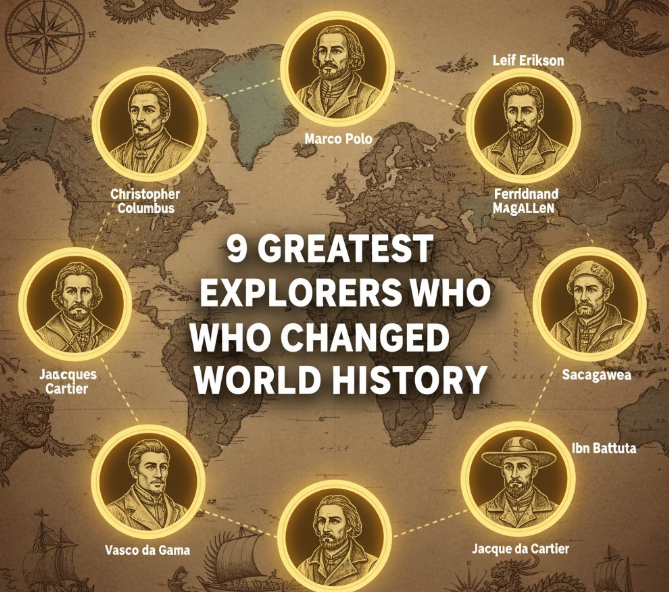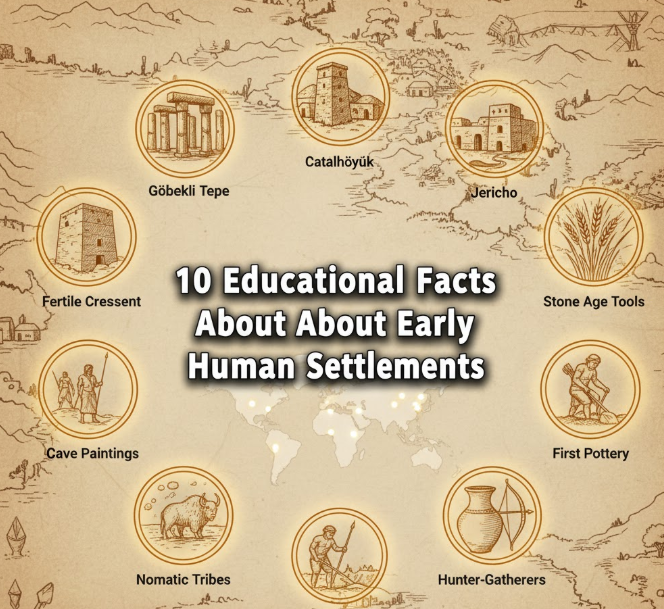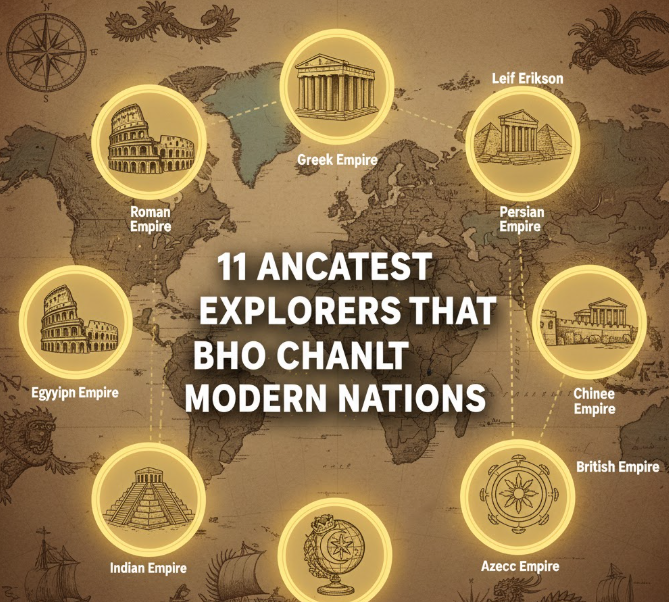From the beginning of mankind, courageous explorers have journeyed into the unknown, facing death in order to discover new worlds, make trade routes and unify civilizations. These adventurers did more than just satiate their curiosity; They changed the whole world. And in their wakes were cultural exchanges, scientific discoveries and sometimes catastrophic consequences for indigenous peoples. This article takes a look at nine of the most famous explorers and their historic expeditions that helped to shape the way human history panned out.
The Importance of Explorers in World History
Before we delve into the particulars of individual explorers, let’s unpack why these daring men are such a big deal. Explorers were the conduits between different ends of the earth. They returned with knowledge of geography, cultures, plants, animals and resources. Their discoveries led to:
- Trade routes that transformed poor nations into wealthy ones
- Cultural exchanges between continents
- Scientific discoveries about our planet
- How contemporary nations were formed
- The migration patterns that built the modern nation-state
Unfortunately, depopulation and warfare in numerous places.
The explorers we are going to talk about were from various times and had different reasons for setting out — some went looking for riches, others had a thirst for knowledge and more than a few did so in the hopes of achieving fame or glory.
Marco Polo – The Story of the Man Who Opened the East to Europe
Journey Across Asia
Marco Polo was not the first European to travel to Asia; he was just the first to leave a written account of his experience. Marco, who was born in Venice, Italy, around 1254, journeyed with his father and uncle along the Silk Road to the court of Kublai Khan, a Mongol emperor of China. The trip took three and a half years and thousands of miles across deserts, over mountains and at the mercy of the people along the way.
Marco Polo lived at the court of Kublai Khan for 17 years. He journeyed across the empire, marveling at customs and technologies and riches that Europeans had never dreamed existed. When he finally came back to Venice in 1295, it was with stories of paper money and coal burning for warmth and postal systems — concepts utterly alien to medieval Europe.
Impact on World History
The book “The Travels of Marco Polo,” by Marco Polo was a medieval bestseller. It set thousands of Europeans dreaming about finding their way to Asia, among them a young man named Christopher Columbus who made notes in his own copy. The contents of the book represented Europeans’ first detailed glimpse of Asian geography, culture and wealth.
His descriptions of:
- The grandeur of Chinese cities
- Valuable spices and silk
- Advanced Asian technologies
- The wealth of the East
These descriptions were to inspire future explorers and began the Age of Exploration. The European discovery of other parts of the world would possibly have developed along quite different lines without Marco Polo’s writing.
Christopher Columbus: The Accidental Revolutionary
Sailing into the Unknown
The Italian navigator, Christopher Columbus who sailed on behalf of Spain searched for a westward route to Asia in the year 1492. Instead, he happened upon the Americas — terrain wholly unfamiliar to Europeans. This “discovery” (from a European point of view — millions of indigenous people already lived there) was one of the most momentous events in history.
Columbus completed four voyages across the Atlantic between 1492 and 1502. He traveled to the Caribbean islands, Central and South America. Columbus died in ignorance of the fact that America was not the eastern fringe of Asia, but two brand new continents.
The Columbian Exchange
Columbus’s journeys spawned what historians refer to as the “Columbian Exchange”, when plants, animals, illnesses, people and cultures moved between hemispheres. This exchange included:
From Americas to Europe/Africa/Asia:
- Potatoes, tomatoes, corn, tobacco, cacao
- Gold and silver
- New agricultural techniques
From Europe/Africa/Asia to Americas:
- Horses, cattle, pigs, sheep
- Wheat, rice, sugar cane
- Unfortunately, devastating diseases like smallpox
Historical Consequences
Columbus’s voyages had massive consequences:
- The Americas are colonized by Europeans
- The indigenous population plummeted due to disease and violence
- The transatlantic slave trade emerged
- Virtually all of the great European powers grew wealthy on the basis of American resources
- The modern nations of the Americas were born
Columbus is honored in some quarters but is also a source of controversy and protest because his voyages are estimated to have caused the suffering and deaths of great numbers of indigenous people.
Vasco da Gama: The Sea Route to India
Breaking the Monopoly
Portuguese explorer Vasco da Gama achieved a dream that obsessed Europeans for decades: finding a sea route from Europe to India, circumnavigating the African continent. In 1497, da Gama set out from Lisbon with four vessels to make his way down the coast of Africa, around the Cape of Good Hope and across the Indian Ocean.
Da Gama finally arrived at Calicut, India in May 1498 after a hazardous ten month voyage of some 24,000 miles. This achievement was earthshaking because for the first time it gave Europeans access to Asian spices, silk and other luxuries without having to do business with Middle Eastern middlemen.
Economic Revolution
Da Gama’s finding would transform world trade:
- Portugal became extremely wealthy from the direct spice trade
- Asian goods tumbled in Europe
- Portuguese trading stations were founded in multiple locations in Asia
- Other European countries scrambled to develop their own eastern circuits
- The control of economic power shifted from the Mediterranean to the Atlantic
Trading Empire
Da Gama’s path brought Portugal a trading empire from Brazil to Japan. Portuguese traders settled in Goa, Malacca, and Macau. For decades they would dominate Asian maritime routes, in the process changing patterns of economic activity forever.
But Portuguese expansion was not all peaceful trade; it meant brutal military conquest as well. Da Gama had himself been a notorious perpetrator of violence against local communities that stood in the way of Portuguese domination.

Ferdinand Magellan: Circumnavigating the Globe and Into History
The Ultimate Voyage
Ferdinand Magellan, a Portuguese navigator traveling with the Spanish fleet, was the commander of the first expedition to circle the world. In 1519, Magellan departed with five ships and roughly 270 men, hoping to discover a westward route to the Spice Islands (now part of Indonesia).
The journey was incredibly difficult. Magellan’s fleet:
- Battled storms and starvation
- Contained mutinies from desperate sailors
- Discovered the Strait at the tip of South America (named the Strait of Magellan)
- Traveled the great distance of the Pacific Ocean longer than thought
The circumnavigation wasn’t actually successful: Magellan himself didn’t survive the trip, having been killed in the Philippines in 1521 during a skirmish with local warriors. But one of his ships, the Victoria, led by Juan Sebastián Elcano, did finally return to Spain in 1522 with only 18 men surviving.
Proving Earth’s True Size
Magellan’s crew established several important points:
- It was possible to sail around the Earth
- The planet turned out to be much larger than had been supposed
- The Pacific Ocean was vast, spanning almost half the Earth
- All one ocean of the world
The expedition proved European ships could go anywhere in the world. It spurred additional investigation and contributed to the development of the first truly global commercial networks.
Zheng He: China and the Oceans in the Early Ming Dynasty
Forgotten Giant of Exploration
European explorers get most of the attention, but Chinese Admiral Zheng He conducted voyages that far outstripped anything the Europeans attempted during the same period. Zheng He led seven colossal voyages between 1405 and 1433 that traversed the Indian Ocean as far as East Africa.
His fleet was extraordinary:
- Ming Dynasty treasure ships topping 400 feet long (far bigger than any ship in Europe)
- Fleets of over 300 vessels
- Crews of up to 28,000 sailors, soldiers and diplomats
- Ships carrying valuable Chinese merchandise such as silk, porcelain and tea
Diplomatic Explorer
Unlike most European explorers, Zheng He’s main goal was not conquest, but diplomacy. He:
- Established trade relationships with dozens of kingdoms
- Showcased Chinese power and culture
- Returned with foreign animals, flowers and knowledge
- Collected tribute from foreign rulers
- Fostered trade peace, not colonization
What Could Have Been
Historians often ponder what would have been if China had pursued Zheng He’s voyages. From 1433, Chinese emperors chose to turn inward and stop exploring the sea. Had China preserved its advantage in seafaring, the Age of Discovery could well have been guided by fleets dispatched by China rather than by Europe.
Zheng He’s expeditions illustrated the Chinese advantages in technology and organization of this time, but are not well known in the West compared to more modest expeditions by Europeans.
James Cook: Mapping the Pacific
Scientific Explorer
British Royal Navy officer Captain James Cook made three voyages to the Pacific Ocean and recorded many visits to Australia and New Zealand. Unlike treasure-hunting conquistadors, Cook was a scientist-explorer. His trips were staffed with astronomers, botanists and artists who took note of whatever they came across.
Cook’s achievements include:
- Mapping New Zealand with unbelievable attention to detail
- Discovering the east coast of Australia
- Traveling the Hawaiian Islands (where he eventually was murdered in 1779)
- He sailed farther south toward Antarctica than anyone else who came before him
- Disproving the existence of a “Great Southern Continent” in temperate places
Advancing Navigation and Science
Cook revolutionized navigation by:
- Making the most intricate maps currently still in use
- Investigations of methods to help prevent scurvy (a fatal disease)
- Documenting the customs of Pacific peoples
- Gathering thousands of plants and animals
His journeys contributed to European understanding of the Pacific, which still remained a largely unexplored region. Cook’s maps allowed future traders, missionaries and colonists to traverse the Pacific Ocean without crashing into anything.
-
Don’t miss: 12 Mind-Blowing Secrets of Ancient Egyptian Life
Complex Legacy
Although Cook is revered as a scientific explorer, his voyages also have been cited as leading to European settlement of Australia, New Zealand and Pacific islands. Contact led to numerous deaths, cultural contamination and decades of violence between native people and white interlopers.
Roald Amundsen’s Triumph Over the Poles
Race to the South Pole
The South Pole was first reached by Norwegian explorer Roald Amundsen. Amundsen and his team won a race against a British expedition led by Robert Falcon Scott to become the first men to reach the southernmost point on Earth, in December 1911.
Amundsen’s triumph stemmed from attention to detail:
- He studied Inuit survival techniques
- Employed sled dogs instead of motor vehicles or ponies
- Established supply depots along the way
- Chose appropriate clothing and equipment
- Began from a better base camp location
Scott, having lagged behind Amundsen on his outward bound journey to the pole, found himself back within distance on his return push. From here, they died.
Master of Polar Exploration
Amundsen’s polar accomplishments include:
- First traverse of the Northwest Passage (1903–06)
- The first man to reach the South Pole (1911)
- First flight over the North Pole (1926)
He was the first man to stand on both poles, and also established himself as history’s greatest polar explorer.
Contributions to Exploration Science
Amundsen’s expeditions advanced understanding of:
- Polar weather patterns and geography
- Survival techniques in extreme environments
- Navigation in frozen seas
- The local magnetic field of the Earth at the poles
His meticulous observations became key to scientists’ understanding of Earth’s polar region, which serves an important function in global climate systems.
Ibn Battuta: The Medieval Wanderer
The Longest Journey
Moroccan scholar Ibn Battuta explored more of the world than any other traveler before the onset of the modern age. It took him between 1325 and 1354 to travel more than 75,000 miles — three times the distance Marco Polo did. His travels carried him to the far reaches of the Islamic world and beyond, from North Africa to China.
Ibn Battuta visited:
- All the Islamic empires of the time
- India, where he worked as a judge
- The Maldives and Sri Lanka
- Southeast Asia and China
- Sub-Saharan Africa, including Timbuktu
Cultural Bridge
The “Rihla”, the detailed travel log of Ibn Battuta, offers historians a remarkable source of information about 14th-century civilizations. He documented:
- Political systems and rulers
- Economic conditions and trade routes
- Religious practices across different regions
- Social customs and daily life
- Geographic features and natural wonders
His texts illustrate the integration of medieval Islamic culture, and reveal that long-distance travel networks were in place hundreds of years before European exploration.
Historical Importance
Ibn Battuta matters because:
- He recorded societies that have subsequently transformed beyond recognition
- His writings are crucial to historians studying medieval Africa, Asia and the Middle East
- He showed that it was feasible for considerable world travel to be accomplished in the medieval era
- His travels reveal just how high Islamic civilization rose
- He demonstrated that curiosity and wanderlust are part of the human constitution
Lewis and Clark: Exploring the American West
Jefferson’s Expedition
In 1804 President Thomas Jefferson asked Meriwether Lewis and William Clark to lead an expedition across the Louisiana Purchase, a huge area of land acquired by America from France. Their mission was to:
- Discover a waterway to the Pacific
- Map the new territory
- Form relationships with the Native American tribes
- Record the botany, wildlife and natural resources
The Lewis and Clark Expedition, or Corps of Discovery, took place from 1804 to 1806. The team sailed up the Missouri River, over the Rocky Mountains to the Pacific Ocean in what is now Oregon.
Sacagawea and Native American Help
The expedition was also successful because of assistance from Native American peoples — especially Sacagawea, a Shoshone woman who helped interpret and guide them. She:
- Aided in conversation with tribes for horses and supplies
- Knew which plants were edible
- Showed that the expedition was a peaceable one (war parties did not go about with women and babies)
- Assisted in translating languages
Lewis and Clark would probably have perished without the help of Native Americans.
Transforming America
The expedition’s consequences were enormous:
- Americans acquired extensive information on the geography of the West
- New maps encouraged westward migration
- There were over 170 new plant species and 120 animals, discovered scientifically
- The presence of economic resources was reported and the first parties began to form
- Unfortunately, this was the start of pushing Native American people off their ancestral land
The journey of Lewis and Clark would work to turn the United States from an Atlantic coastal nation into a transcontinental power reaching the Pacific.
For more information about the Lewis and Clark expedition, visit the National Park Service’s comprehensive historical overview.
Comparative Overview of Explorers
| Explorer | Time Period | Main Accomplishment | Region Traversed | Historical Impact |
|---|---|---|---|---|
| Marco Polo | 1271-1295 | Opened East-West dialogue | Asia, China | Set stage for Age of Exploration |
| Christopher Columbus | 1492-1502 | Discovered Americas | Caribbean, Central America | Linked hemispheres, initiated imperialism |
| Vasco da Gama | 1497-1499 | Sea route to India | Africa, Indian Ocean | Revolutionized global trade |
| Ferdinand Magellan | 1519-1522 | First global circumnavigation | Global | Demonstrated Earth’s size and shape |
| Zheng He | 1405-1433 | Gigantic Chinese expeditions | Indian Ocean, Africa | Showed Chinese sea power |
| James Cook | 1768-1779 | Mapped Pacific | Pacific Ocean, Australia | Advanced science of discovery |
| Roald Amundsen | 1903-1926 | Reached both poles | Arctic and Antarctic | Mastered Earth’s extremes |
| Ibn Battuta | 1325-1354 | Longest medieval journey | Islamic world, Asia, Africa | Chronicled medieval cultures |
| Lewis & Clark | 1804-1806 | Explored American West | Western North America | Made U.S. expansion possible |
The Dark Side of Exploration
It is worth noting the horrible effects on indigenous populations of such expeditions, as we celebrate these explorers:
Disease: European explorers introduced smallpox, measles and other diseases that wiped out millions of indigenous people with no immunity.
Colonization: Exploration resulted in European powers establishing control over peoples and places, generally covering lands in which there were already people and established civilizations with force.
Slavery: Breakthroughs paved the way for the transatlantic slave trade, resulting in untold human misery.
Annihilation Of Culture: Colonizers that succeeded explorers annihilated several indigenous languages, religions and practices.
Resource Extraction: Colonists harvested wealth from conquered places, typically impoverishing the local population in the process.
Modern historians acknowledge that “discovery” is a problematic term — you can’t discover land where people already live. These world explorers altered history, but not always for the good.
A History of Exploration Technology
Explorers relied on technology of their time:
Middle Ages (Marco Polo, Ibn Battuta):
- On foot, horse or camel
- Basic maps, local guides
- Navigated by stars and landmarks
- Journey could take years
Age of Sail (Columbus, da Gama, Magellan, Cook):
- Sailing ships powered by wind
- Compass for direction
- Astrolabe and sextant for latitude
- Improved maps and charts
- Yet still, it would take months to cross oceans
Modern Era (Amundsen, early 20th century):
- Steamships and motor vehicles
- Telegraph communication
- Advanced meteorology
- Airplane support
- Scientific instruments
- Better cold-weather equipment
Every technological breakthrough allowed for exploration that was safer, quicker and more thorough. Now explorers have access to satellites, GPS and global communication that would have been unimaginable to the explorers of the past.

What Motivated These Explorers?
Different explorers had different motivations:
Economic Gain: Many explorers hoped to become rich through trade, resources, or plunder. Columbus, da Gama and Magellan were hoping to make a profit by discovering trade routes to Asia.
Religious Mission: Some expeditions intended to spread their religion. Spanish explorers often mixed conquest with Christianizing America’s indigenous population.
Scientific Curiosity: Explorers, such as Cook and the members of Lewis and Clark’s expedition, sought to discover foods or materials that could be used in other parts of their empires.
National Glory: Governments sponsored expeditions for the purpose of expanding their strength and prestige. Explorers like Zheng He flaunted their nation’s power.
Personal Fame: For many explorers, the desire to be recognized or known, and their journey recorded in history books was an obsession. Amundsen’s dash to the South Pole was fueled in part by a desire for competitive glory.
Adventure: Some people liked the excitement of discovering new places. Ibn Battuta had the genuine curiosity of wanderlust.
Most early explorers had several motivations — economic, scientific, religious and personal interests were all mixed together.
Frequently Asked Questions
Who was the world’s first explorer?
There is no clear answer to this question. Humans have been exploring since time immemorial — leaving Africa to fan across every continent. The first voyagers on record are ancient Phoenicians and Polynesians who traversed oceans thousands of years ago.
How come the era of exploration began in the 15th century?
Many things contributed: Europeans desired direct access to Asia’s spices and other goods; navigation technology had improved, with more advanced ships, compasses and maps; powerful monarchies could bankroll costly expeditions; and Marco Polo’s writings inspired generations of Europeans to dream of reaching Asia.
Which explorer traveled the farthest?
Ibn Battuta made it farthest on his own feet before the automobile era, racking up more than 75,000 miles in 29 years of travel. But Magellan’s fleet did finish the longest single voyage in history as no one else had yet circumnavigated the planet.
Were there women explorers in history?
Yes, though they’re often overlooked. Sacagawea assisted Lewis and Clark. Jeanne Baret was the first woman to circle the earth (disguised as a man). Isabella Bird explored numerous miles in the 19th century. Most historical accounts of the explorers are about men, but women contributed to exploration in important ways.
How did explorers travel before GPS?
Navigators relied on celestial navigation, watching the sun, moon and stars and making educated guesses about where they were and how far they had to go. They had instruments in the form of the compass (for direction), astrolabe and sextant (for latitude) and chronometer (for longitude). Coastal navigators typically used landmarks and accurate maps. They hired local guides in foreign lands.
What was the most perilous about exploration in history?
Disease was likely the single largest killer. Scurvy (a vitamin C deficiency) killed thousands of sailors. Explorers also had to contend with shipwrecks, attacks, getting lost, or being stranded in such a way that they could not call for help. Magellan’s crew began with 270 men, but only 18 made it back.
Are there any places left on Earth to explore?
Much of Earth’s surface is mapped, but deep ocean trenches are still largely a mystery. Researchers uncover new species in the depths of remote rain forests, caves and deep ocean. Today, explorers are more interested in space, deep oceans and understanding the microscopic world than they are in uncharted lands.
In what ways did exploration affect the lives of indigenous peoples?
Almost always negatively. Indigenous populations were ravaged by diseases, war, slavery, land theft and the destruction of culture. Whole tribes were wiped out. But some native societies were able to turn European tools, animals and crops into advantages. The effects were different but equally devastating to Indigenous peoples.
Deep Lessons from the Greatest Explorers in History
These nine explorers changed history in fundamental ways. They:
- Connected distant parts of the world to each other
- Expanded human knowledge of geography, biology, and cultures
- Established global trading networks that still exist today
- Challenged, mentored and inspired future generations of exploration
- Demonstrated human courage, curiosity and resolve
However, their legacy is complex. We celebrate episodes such as these for their daring and success, but we should also take into account the misery that such explorations brought to countless indigenous peoples. Nowadays, exploration is about science and understanding rather than claiming territory and resources.
The time has not come to cease discovering. Modern explorers are leaving no stone unturned as they probe the ocean’s deepest depths, scan remote planets and focus on microscopic worlds. They too inherit the heritage of these giants that had walked before them—the burning desire to see what is beyond the horizon.
These nine pioneers show us that the greatest of human accomplishments are made by those who are willing to go where none have gone before, even when such a journey might seem impossible. Their tales still fuel imaginations of explorers, researchers and visionaries around the globe that curiosity and courage can make a difference.




